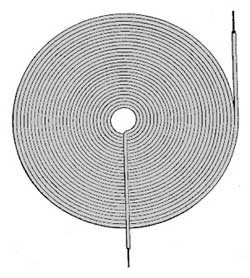

Therefore, the first action of the air gap in this application is to prevent saturation (it also changes the permeability and hence the inductance as well).īecause we normally know the applied ac voltage stress on the choke, we can apply this to the vertical scale, B, using the dc flux line (B dc) as the mean value. We enter this with the known parameter (dc current) on the horizontal scale, H.īy projecting this upward, the gapped core intercept at Bdc is not saturated, while the nongapped core intercept (top line) is well into saturation (at B sat). 2, you can see one quadrant of the previous B/H loop for a ferrite core, with and without an air gap. In choke applications, we normally know the dc current (typically, the mean dc load current applied to the output filter in a switchmode power supply). In continuous conduction chokes, flyback “transformers,” and single-ended forward transformers, the function of the air gap is different (flyback transformers are really chokes with extra isolated windings). Keep in mind that the gap will not prevent saturation in true transformer applications. In some cases, a very small air gap may be used in a transformer to define the primary inductance and reduce manufacturing variations. Thus, in the transformer example, the gap is used to reduce the inductance (perhaps for resonant applications). The increase in the magnetizing current between nongapped and gapped cores is clearly shown by projection from the intercepts on the B/H loops. The horizontal scale H (magnetizing force, Oersted) is proportional to current when the core size, permeability, and turns have been defined. Remember that magnetizing current flows in the primary - even if the secondary is open circuit. In the case of a transformer or inductor, the air gap only reduces the slope of the B/H loop, reducing permeability and inductance, and hence increasing the magnetizing current in the primary. Hence, if the applied voltage were to be increased to the point of saturation, introducing an air gap wouldn't help. Notice that when the peak value of (Bm) is projected right so as to intersect with the non-gapped and gapped B/H loops, the margin between the peak working point (Bm) and the saturation value (Bsat) remains the same with or without the air gap.

This is shown to the left of the diagram. For this example a square wave voltage (Vin) is to be considered. If we assume that the core size, primary turns, and frequency are predefined, the vertical scale B (flux density, Tesla) is proportional to the applied voltage (V in) (you may prefer to think of it in terms of volt seconds). (A transformer or inductor, is only polarized with ac, while a choke or fly-back transformer has both dc and ac current components). To start, we will assume the core is to be used for a high frequency transformer or an inductor. The steep slope (high permeability) is for a core without an air gap and the more gradual slope for the same core with a small air gap. 1 shows two idealized B/H loops for a typical Ferrite core. Further, the air gap has several other critical functions.įig. In fact, in a transformer, the air gap will not prevent saturation caused by excessive ac voltage polarization, as we will see. What exactly is the function of the air gap? When asked this question, most engineers respond, “It prevents core saturation.” Although this may be true in certain cases, it's not true in general.


 0 kommentar(er)
0 kommentar(er)
